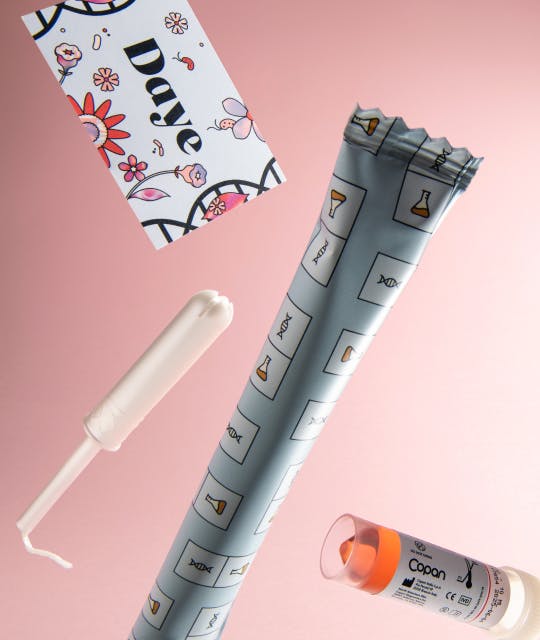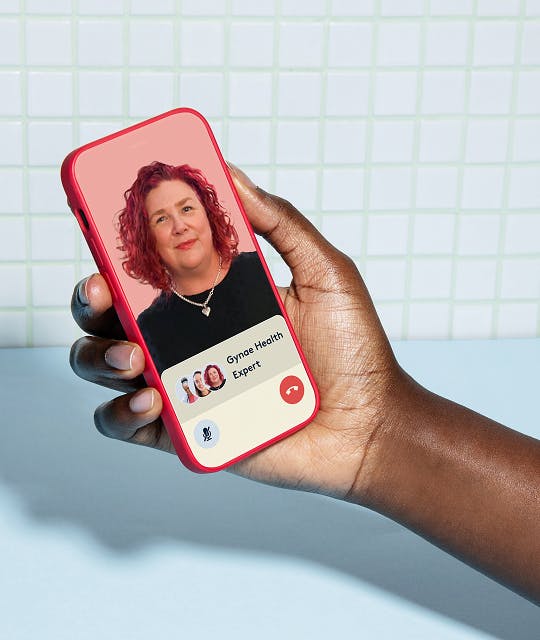Table of contents
1. What Makes a Period "Normal"?
2. What Should My Period Blood Look Like?
3. What If I'm Bleeding Outside My Period
4. Your Period Shouldn't Rule Your Life
5. Understanding Your Discharge
6. Taking Control of Your Period Health
Written by Valentina Milanova
Medically reviewed by Sarah Montagu (RN DFSRH, BSc)
Illustrated by Maria Papazova
What you'll learn:
- What makes a period "normal" and what doesn't
- The 5 key signs of a healthy menstrual cycle
- Common period problems and when to seek help
- How to track and manage your period health
It's a question that's crossed most of our minds: "Is my period normal?" With limited menstrual education in schools and the stigma that still surrounds period talk, it's no surprise many of us are left wondering. To make matters worse, gynaecological conditions that impact our periods are severely undiagnosed – the average time it takes to get diagnosed with endometriosis in the UK is eight years.
It's time to change this. The more we know about what a healthy menstrual cycle looks and feels like, the better we can spot the signs that something is not quite right. Knowledge is power; with more understanding of the natural variations in your menstrual cycle, the better you can take control of your gynaecological health and advocate for yourself at the doctor's office
So, what exactly are the signs that your menstrual cycle is healthy? Let's explore all the signs of a healthy cycle and discuss some of the red flags to look out for.

What Makes a Period "Normal"?
The Timing Sweet Spot
The menstrual cycle covers the time from the first day of your last period to the day before your next period. While you might have heard that 28 days is the "normal" cycle length, that's just an average. According to the NHS, 'regular cycles that are longer or shorter than this, from 23 to 35 days, are normal.'
When Irregular Isn't Normal
Periods are considered irregular if the gap between them is less than 21 days or more than 35 days, but irregular periods aren't necessarily a sign of a problem. For example, when you first start having periods during puberty, it's common for them to be irregular. Hormonal birth control, weight changes, stress, and over-exercising can all also contribute to irregular periods.
See a doctor if your irregular periods come with:
- Unexplained tiredness
- Weight changes
- New hair growth on your face
- Difficulty conceiving
- Bleeding between periods
These could indicate conditions like polycystic ovary syndrome (PCOS). It's also worth noting that irregular bleeding might signal a sexually transmitted infection, especially if you experience:
- Bleeding after sex
- Pain during intercourse
- Intermittent abdominal pain
Pro tip: Daye's Diagnostic Tampon can screen for STIs from the comfort of your home, making it easier to get answers and peace of mind.

What Should My Period Blood Look Like?
The Color Spectrum Explained
Your period blood is like a mood ring – it can vary in colour from the bright red of a fire engine or stop sign all the way to dark brown or black, and most are completely normal:
- Bright Red: Fresh blood, typically seen at the beginning of your period
- Dark Red: Blood that's taken a bit longer to leave your body
- Brown or Black: Oxidized blood that's been around longer
- Pink: Usually indicates a lighter flow mixed with cervical fluid
Each color tells a story about your flow and where you are in your period. Brown discharge at the start or end of your period? That's just older blood making its exit – totally normal.
When to Raise the Red Flag
While most colors are normal, some deserve medical attention:
- Orange: Could indicate infection or mixed cervical fluid
- Grey: Might signal bacterial vaginosis or other infections
- Any unusual colors with strong odors

What If I'm Bleeding Outside My Period
Understanding Intermenstrual Bleeding
Here's a simple truth: bleeding should only happen during your period. Any bleeding outside your regular period (sometimes called spotting or intermenstrual bleeding) deserves attention, even if it seems minor.
While occasional spotting with birth control is common (especially when starting something new), other types of between-period bleeding might signal underlying issues like:
- Pelvic infections
- Polyps (small growths in your uterus or cervix)
- Cervical changes that need checking
- Hormonal imbalances
- Certain medications
What to Watch For
Pay attention to:
- Spotting between periods
- Bleeding after sex
- Irregular brown discharge outside your period
- Any unexplained bleeding, no matter how light
Remember: Even if spotting seems mild, it's worth mentioning to your healthcare provider. While it might be nothing serious, it's one of those symptoms that's better to get checked out - just in case.

Your Period Shouldn't Rule Your Life
Understanding Period Pain
Let's talk about those dreaded cramps. Period pain occurs when prostaglandins (a chemical in your body) tell your uterus to contract over and over again, helping shed and expel the uterine lining. The contractions compress your blood vessels and reduce the flow of oxygen in the area, causing the pain you feel as cramps. While research into the causes of period pain is still limited, it's thought that when your body creates an excess of prostaglandins this causes stronger cramps and therefore more severe pain.
Some cramping is normal, but your period shouldn't:
- Keep you home from work or school
- Cause severe pain that OTC painkillers can't touch
- Make you miss out on daily activities
- Last longer than a few days
If you're experiencing period pain so severe it disrupts your life, it's important to talk to a medical professional. The pain could be caused by an underlying condition such as pelvic inflammatory disease (PID), endometriosis, uterine fibroids, or something else. Finding out more about the cause of your pain means you can find ways to manage it so it no longer affects your life as much.
Take the pain out of your period
90% of us experience period pain, and when left unmanaged it leads to us losing 150 million productive work days per year.

PMS vs PMDD: Know the Difference
About three in four menstruators experience PMS symptoms like:
- Mood swings
- Tiredness
- Bloating
- Breast tenderness
- Irritability
Most PMS symptoms can be managed with:
- Adequate sleep
- Regular exercise
- Healthy eating
- Over-the-counter pain relief
- Stress management techniques
However, some people experience premenstrual dysphoric disorder (PMDD), which has similar but more intense symptoms like:
- Intense depression
- Severe anxiety
- Physical pain
- Overwhelming fatigue
- Suicidal thoughts
- Extreme mood changes
If PMS is seriously impacting your life, treatments are available, including:
- Anti-inflammatory medicines
- SSRIs (selective serotonin reuptake inhibitors)
- Birth control pills
- Specific vitamin supplements

Understanding Your Discharge
Normal Discharge Changes
A healthy menstrual cycle is about more than just the time you spend bleeding; the changes in your vaginal discharge can also indicate a healthy cycle.
Your vaginal discharge is like your body's personal calendar, changing throughout your cycle:
- Before ovulation (around day 14 of your cycle): Creamy white or cloudy
- During ovulation: Clear and stretchy (like egg white)
- After ovulation: Sticky or dry
And don't worry too much if you see brown discharge – even though it might look alarming, it's usually just regular discharge that contains a little leftover blood from a previous period.
When to Get Checked
While some variation in discharge is normal and healthy throughout your cycle, there are a few types of discharge to look out for as these can signify an infection:
- Green or grey (possible trichomoniasis)
- Fishy-smelling (potential bacterial vaginosis)
- Cottage cheese-like (could be thrush or chlamydia)
- Accompanied by itching or burning
If you're concerned about your discharge, try our at-home STI and vaginal microbiome screening which can help you get answers and treatment from the comfort of your own home, and if you want to find out more about why your discharge changes so much throughout the month, check out our guide to how your discharge changes throughout your cycle.
Taking Control of Your Period Health
Your Period Detective Kit
Becoming a period detective isn't just about marking days on a calendar (though that helps). Here's what to track:
- Cycle length
- Flow heaviness
- Pain levels and locations
- Other symptoms (mood changes, breast tenderness, etc.)
- Energy levels
- Sleep patterns
Use a period tracking app or good old pen and paper – whatever works for you. The important thing is consistency.
Taking Control of Your Period Health
When it comes to periods, there's so much variation between people that it can be hard to tell what's normal. There are some symptoms that you should always seek medical advice about, such as bleeding between periods, intense period pain, or unusual discharge. However, it's also important to get to know your own period so you can figure out what's normal for you.
The Bigger Picture
Here's a shocking stat: only 2% of medical research funding goes towards female reproductive health, pregnancy, and childbirth. There's a long way still to go in researching and providing treatment for gynae health problems.
That's why we created the Daye Period & Pelvic Pain Clinic. We're here to:
- Connect you with period pain specialists
- Provide personalised pain relief plans
- Help fast-track diagnosis of conditions like endometriosis, adenomyosis, and PID
- Support you in taking control of your period health
Ready to transform your period? Get started by requesting your period pain report today.
Related Products








